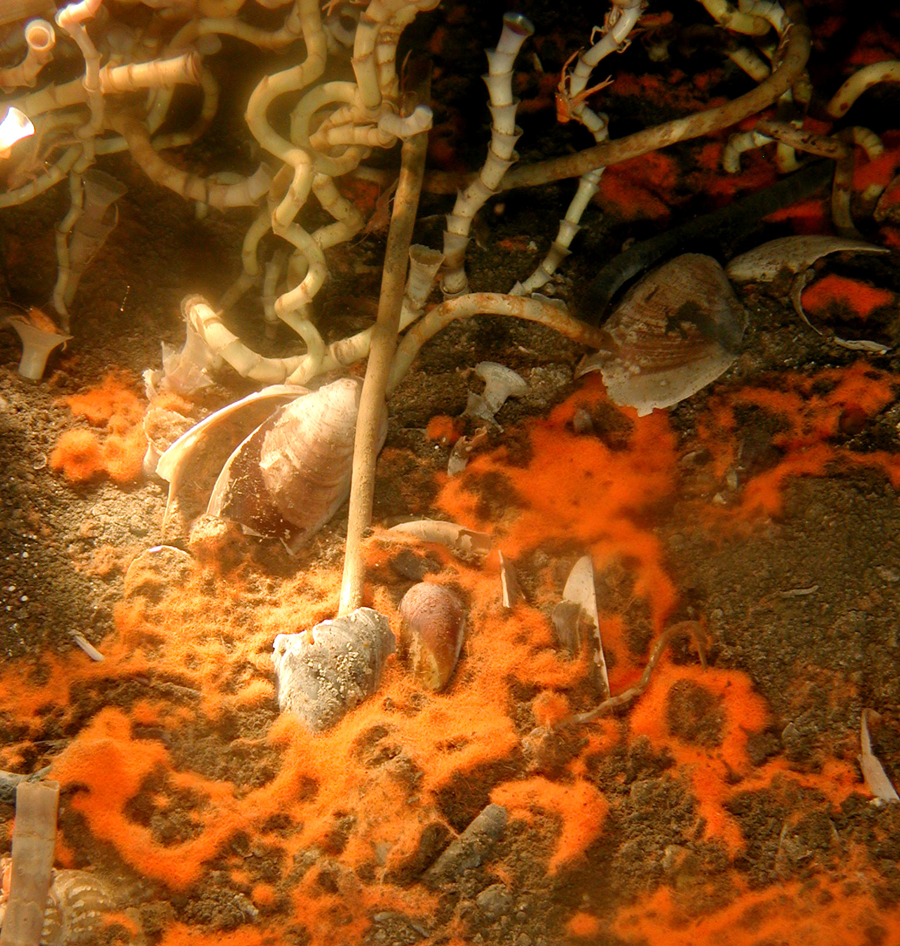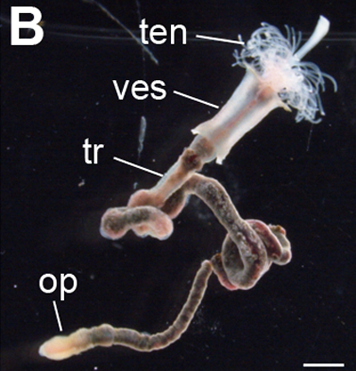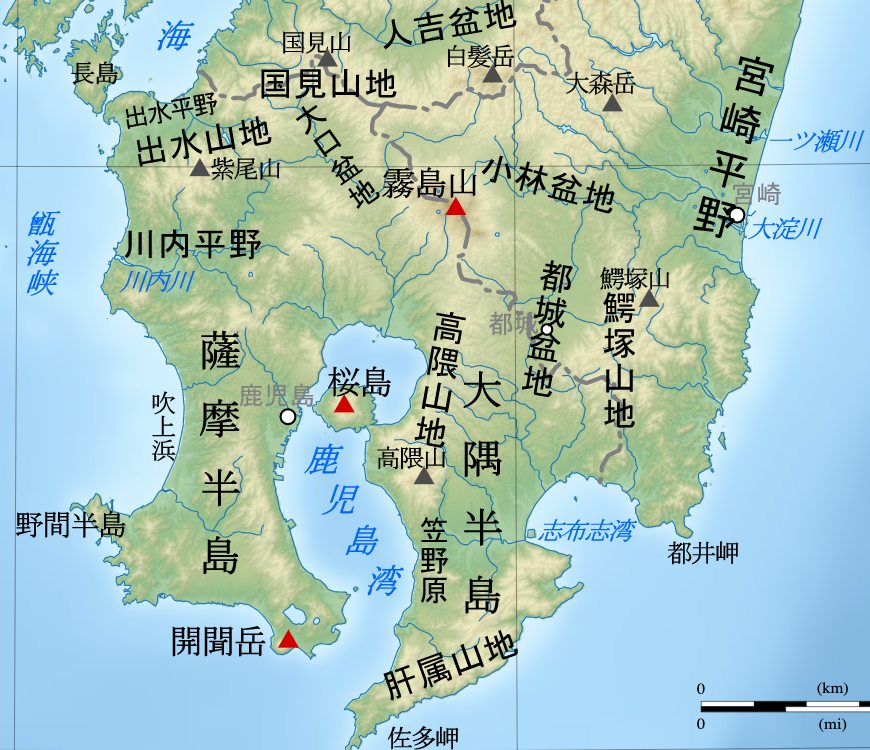|
Lamellibrachia
''Lamellibrachia'' is a genus of tube worms related to the giant tube worm, ''Riftia pachyptila''. They live at deep-sea cold seeps where hydrocarbons (oil and methane) leak out of the seafloor, and are entirely reliant on internal, sulfide-oxidizing bacterial symbionts for their nutrition. The symbionts, gammaproteobacteria, require sulfide and inorganic carbon (carbon dioxide). The tube worms extract dissolved oxygen and hydrogen sulfide from the sea water with the crown of plumes. Species living near seeps can also obtain sulfide through their "roots", posterior extensions of their body and tube. Several sorts of hemoglobin are present in the blood and coelomic fluid to bind to the different components and transport them to the symbionts. ''L. luymesi'' provides the bacteria with hydrogen sulfide and oxygen by taking them up from the environment and binding them to a specialized hemoglobin molecule. Unlike the tube worms that live at hydrothermal vents, ''L. luymesi'' uses ... [...More Info...] [...Related Items...] OR: [Wikipedia] [Google] [Baidu] |
Cold Seep
A cold seep (sometimes called a cold vent) is an area of the ocean floor where hydrogen sulfide, methane and other hydrocarbon-rich fluid seepage occurs, often in the form of a brine pool. ''Cold'' does not mean that the temperature of the seepage is lower than that of the surrounding sea water. On the contrary, its temperature is often slightly higher. The "cold" is relative to the very warm (at least ) conditions of a hydrothermal vent. Cold seeps constitute a biome supporting several endemic species. Cold seeps develop unique topography over time, where reactions between methane and seawater create carbonate rock formations and reefs. These reactions may also be dependent on bacterial activity. Ikaite, a hydrous calcium carbonate, can be associated with oxidizing methane at cold seeps. Types Types of cold seeps can be distinguished according to the depth, as shallow cold seeps and deep cold seeps. Cold seeps can also be distinguished in detail, as follows: * oil/gas ... [...More Info...] [...Related Items...] OR: [Wikipedia] [Google] [Baidu] |
Lamellibrachia Donwalshi
''Lamellibrachia'' is a genus of tube worms related to the giant tube worm, ''Riftia pachyptila''. They live at deep-sea cold seeps where hydrocarbons (oil and methane) leak out of the seafloor, and are entirely reliant on internal, sulfide-oxidizing bacterial symbionts for their nutrition. The symbionts, gammaproteobacteria, require sulfide and inorganic carbon (carbon dioxide). The tube worms extract dissolved oxygen and hydrogen sulfide from the sea water with the crown of plumes. Species living near seeps can also obtain sulfide through their "roots", posterior extensions of their body and tube. Several sorts of hemoglobin are present in the blood and coelomic fluid to bind to the different components and transport them to the symbionts. ''L. luymesi'' provides the bacteria with hydrogen sulfide and oxygen by taking them up from the environment and binding them to a specialized hemoglobin molecule. Unlike the tube worms that live at hydrothermal vents, ''L. luymesi'' uses a ... [...More Info...] [...Related Items...] OR: [Wikipedia] [Google] [Baidu] |
Lamellibrachia Juni
''Lamellibrachia'' is a genus of tube worms related to the giant tube worm, ''Riftia pachyptila''. They live at deep-sea cold seeps where hydrocarbons (oil and methane) leak out of the seafloor, and are entirely reliant on internal, sulfide-oxidizing bacterial symbionts for their nutrition. The symbionts, gammaproteobacteria, require sulfide and inorganic carbon (carbon dioxide). The tube worms extract dissolved oxygen and hydrogen sulfide from the sea water with the crown of plumes. Species living near seeps can also obtain sulfide through their "roots", posterior extensions of their body and tube. Several sorts of hemoglobin are present in the blood and coelomic fluid to bind to the different components and transport them to the symbionts. ''L. luymesi'' provides the bacteria with hydrogen sulfide and oxygen by taking them up from the environment and binding them to a specialized hemoglobin molecule. Unlike the tube worms that live at hydrothermal vents, ''L. luymesi'' uses a ... [...More Info...] [...Related Items...] OR: [Wikipedia] [Google] [Baidu] |
Lamellibrachia Anaximandri
''Lamellibrachia'' is a genus of tube worms related to the giant tube worm, ''Riftia pachyptila''. They live at deep-sea cold seeps where hydrocarbons (oil and methane) leak out of the seafloor, and are entirely reliant on internal, sulfide-oxidizing bacterial symbionts for their nutrition. The symbionts, gammaproteobacteria, require sulfide and inorganic carbon (carbon dioxide). The tube worms extract dissolved oxygen and hydrogen sulfide from the sea water with the crown of plumes. Species living near seeps can also obtain sulfide through their "roots", posterior extensions of their body and tube. Several sorts of hemoglobin are present in the blood and coelomic fluid to bind to the different components and transport them to the symbionts. ''L. luymesi'' provides the bacteria with hydrogen sulfide and oxygen by taking them up from the environment and binding them to a specialized hemoglobin molecule. Unlike the tube worms that live at hydrothermal vents, ''L. luymesi'' uses a ... [...More Info...] [...Related Items...] OR: [Wikipedia] [Google] [Baidu] |
Lamellibrachia Luymesi
''Lamellibrachia luymesi'' is a species of tube worms in the family Siboglinidae. It lives at deep-sea cold seeps where hydrocarbons (oil and methane) are leaking out of the seafloor. It is entirely reliant on internal, sulfide-oxidizing bacterial symbionts for its nutrition. These are located in a centrally located "trophosome". ''Lamellibrachia luymesi'' provides the bacteria with hydrogen sulfide and oxygen by taking them up from the environment and binding them to a specialized hemoglobin molecule. Unlike the tube worms ''Riftia pachyptila'' that live at hydrothermal vents, ''L. luymesi'' uses a posterior extension of its body called the root to take up hydrogen sulfide from the seep sediments. ''L. luymesi'' may also help fuel the generation of sulfide by excreting sulfate through their roots into the sediments below the aggregations. To support the carbon fixation they need for maintenance and growth, ''L. luymesi'' needs to extract sulfide, oxygen, and inorganic carbon ... [...More Info...] [...Related Items...] OR: [Wikipedia] [Google] [Baidu] |
Lamellibrachia Columna
''Lamellibrachia columna'' is a vestimentiferan tube worm from the South Pacific Ocean that has been shown to be very closely related genetically to ''Lamellibrachia satsuma ''Lamellibrachia satsuma'' (also known as Satsuma tubeworm or Satsumahaorimushi or ) was discovered near a hydrothermal vent in Kagoshima Bay, Kagoshima at the depth of only the shallowest depth record for a vestimentiferan. Its symbiotic s ...'' found in Japanese waters. References Sabellida Animals described in 1991 Fauna of the Pacific Ocean {{Annelid-stub ... [...More Info...] [...Related Items...] OR: [Wikipedia] [Google] [Baidu] |
Vestimentiferan
Siboglinidae is a family of polychaete annelid worms whose members made up the former phyla Pogonophora and Vestimentifera (the giant tube worms). The family is composed of about 100 species of vermiform creatures which live in thin tubes buried in sediments (Pogonophora) or in tubes attached to hard substratum (Vestimentifera) at ocean depths ranging from . They can also be found in association with hydrothermal vents, methane seeps, sunken plant material, and whale carcasses. The first specimen was dredged from the waters of what is now Indonesia in 1900. These specimens were given to French zoologist Maurice Caullery, who studied them for nearly 50 years. Anatomy Most siboglinids are less than in diameter, but in length. They inhabit tubular structures composed of chitin and fixed to rocks or substrate. The tubes are often clustered together in large colonies. Their bodies are divided into four regions. The anterior end is called the cephalic lobe, which bears from one to ... [...More Info...] [...Related Items...] OR: [Wikipedia] [Google] [Baidu] |
Kagoshima Bay
also known as Kinkō Bay, is a deep inlet of the East China Sea on the coast of Japan.''Merriam Webster's Geographical Dictionary, Third Edition'', p. 562. Kagoshima Bay is on the south coast of the island of Kyūshū. The port city of Kagoshima and its well-protected harbor lie on the bay's western coast, just opposite the island of Sakurajima. Geology The bay itself is partially volcanic in origin, with two massive submarine calderas shaping part of the bay's shoreline: The younger Aira Caldera in the northernmost part of the bay, and the older Ata Caldera at the mouth of the bay where it meets the East China Sea. Both calderas formed during the Pleistocene from highly explosive Ultra-Plinian volcanic eruptions, Aira approximately 22,000 years ago and Ata approximately 105,000 years ago. Though such enormous eruptions are extremely infrequent, both volcanoes have remained active with much smaller eruptions in historic times, with Sakurajima in the bay and the Kirishima ... [...More Info...] [...Related Items...] OR: [Wikipedia] [Google] [Baidu] |
Lamellibrachia Barhami
''Lamellibrachia barhami'' is a large pogonophore. Description Its tentacular crown is formed of several, fused, horseshoe-shaped tentacle lamellae. The second segment has two body folds, near which open the genital ducts. The trunk, which comprises 89% of its total body length, is undifferentiated. The true metasoma is without setae. The heart is a simple muscular elaboration of the anterior end of the ventral blood vessel. The brain is large, and from it arises a pair of intraepidermal The epidermis is the outermost of the three layers that comprise the skin, the inner layers being the dermis and hypodermis. The epidermis layer provides a barrier to infection from environmental pathogens and regulates the amount of water relea ... nerve cords, which extend the full length of the vestimental region; thereafter, they join and form the a nerve cord of the trunk. Associated with the brain and the nerve cords are the dorsal tubes. References Further reading *Kiel, Steffen, ... [...More Info...] [...Related Items...] OR: [Wikipedia] [Google] [Baidu] |
Riftia Pachyptila
''Riftia pachyptila'', commonly known as the giant tube worm and less commonly known as the Giant beardworm, is a marine invertebrate in the phylum Annelida (formerly grouped in phylum Pogonophora and Vestimentifera) related to tube worms commonly found in the intertidal and pelagic zones. ''R. pachyptila'' lives on the floor of the Pacific Ocean near hydrothermal vents, the vents provide a natural ambient temperature in their environment ranging from 2 to 30 °C, at the same time it can tolerate extremely high hydrogen sulfide levels. These worms can reach a length of , and their tubular bodies have a diameter of . Its common name "giant tube worm" is, however, also applied to the largest living species of shipworm, ''Kuphus polythalamius'', which despite the name "worm", is a bivalve mollusc rather than an annelid. Discovery ''R. pachyptila'' was discovered in 1977 on an expedition of the American bathyscaphe DSV ''Alvin'' to the Galápagos Rift led by geologist J ... [...More Info...] [...Related Items...] OR: [Wikipedia] [Google] [Baidu] |
Tube Worm
A tubeworm is any worm-like sessile invertebrate that anchors its tail to an underwater surface and secretes around its body a mineral tube, into which it can withdraw its entire body. Tubeworms are found among the following taxa: * Annelida, the phylum containing segmented worms ** Polychaetea, the class containing bristle worms *** Canalipalpata, the order containing bristle-footed annelids or fan-head worms **** Siboglinidae, the family of beard worms ***** ''Riftia pachyptila'', a species known as giant tube worms ***** Lamellibrachia, a genus **** Serpulidae, a family **** Sabellidae, the family containing feather duster worms * Phoronida, the phylum containing horseshoe worms * Microconchida, an order of extinct tubeworms * ''Kuphus polythalamia ''Kuphus polythalamius'' is a species of shipworm, a marine bivalve mollusc in the family Teredinidae. Description The tube of ''Kuphus polythalamius'' is known as a crypt and is a calcareous secretion designed to enable the animal ... [...More Info...] [...Related Items...] OR: [Wikipedia] [Google] [Baidu] |
Greg W
Greg is a masculine given name, and often a shortened form of the given name Gregory. Greg (more commonly spelled " Gregg") is also a surname. People with the name *Greg Abbott (other), multiple people *Greg Abel (born 1961/1962), Canadian businessman *Greg Adams (other), multiple people *Greg Allen (other), multiple people *Greg Anderson (other), multiple people *Greg Austin (other), multiple people *Greg Ball (other), multiple people *Greg Bell (other), multiple people *Greg Bennett (other), multiple people *Greg Berlanti (born 1972), American writer and producer *Greg Biffle (born 1969), American NASCAR driver * Greg Blankenship (born 1954), American football player *Greg Boyd (other), multiple people *Greg Boyer (other), multiple people * Greg Brady (broadcaster) (born 1971), Canadian sports radio host *Greg Brock (baseball) (born 1957), American baseball player *Greg Brooker (disambiguati ... [...More Info...] [...Related Items...] OR: [Wikipedia] [Google] [Baidu] |




_(22754473376).jpg)